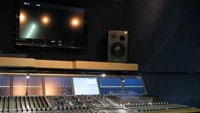BBC Radio OBs set to go mobile with Stagetec

German mixing desk manufacturer Stagetec will supply BBC Radio’s outside broadcast trucks with five AURUS consoles and NEXUS routing and infrastructure for all six vehicles in the fleet of general purpose and music sound trucks. The systems deliver the flexibility and ease of use essential to meet the demands of the extremely wide range of recording and broadcasting tasks expected of the vehicles.
The four general purpose trucks are each fitted with a 40-fader Stagetec AURUS console. The general purpose vehicles are fixed-chassis, 30ft trucks equipped with Stagetec’s 40-fader direct access control surface, a 40962 central router and four remote stage boxes, with each box connected by military-grade fiber optics to the truck. The two music trucks are 40ft trailers with a 48-fader control surface and just two stage boxes with 64 channels of Stagetec’s 158dB mic inputs apiece.
The first of the general purpose vehicles, Sound 6, made its debut at the University of Derby as part of Radio 4’s University Tour across England and Wales. Parked on campus for two days, Sound 6 recorded programs as diverse as “The Bottom Line” with Evan Davis, “Just a Minute” with Nicholas Parsons, “The Music Group” with Phil Hammond and a live broadcast of “Woman’s Hour” with singer Alison Moyet.
Sound 5 had its first outing on Oct. 30, broadcasting Radio 5’s live Simon Mayo show featuring Sparks, Johnny Marr and live music from Snow Patrol, from Maida Vale on the 75th anniversary of the studios’ association with the BBC.
One of the primary benefits of the AURUS console is that the bus and channel configuration can be matched to each application and the setup loaded in just a few seconds. The AURUS control surface benefits from the latest digital control and processing and features a traditional analog-style channel strip, making it a familiar tool for any engineer.
The new BBC Radio OB fleet will be fully operational by spring of 2010 and will eventually replace the oldest vehicles in the existing fleet, which were built more than 20 years ago.
The professional video industry's #1 source for news, trends and product and tech information. Sign up below.
